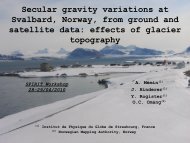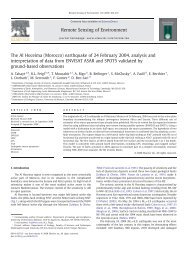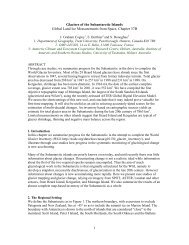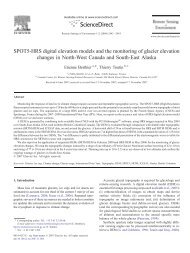Surface motion of mountain glaciers derived from satellite optical ...
Surface motion of mountain glaciers derived from satellite optical ...
Surface motion of mountain glaciers derived from satellite optical ...
You also want an ePaper? Increase the reach of your titles
YUMPU automatically turns print PDFs into web optimized ePapers that Google loves.
20E. Berthier et al. / Remote Sensing <strong>of</strong> Environment 95 (2005) 14–2819 August 2003 (image pair #1) are also combined toestimate the displacement during 31 days. This pair is usedto test a less favourable <strong>satellite</strong> configuration (with adifference <strong>of</strong> 8.58 in the incidence angles) and to determinewhether the <strong>glaciers</strong> can experience short-term velocitychange.All these images were acquired with the lowest possiblegain. A low gain avoids radiometric saturation on theglacier, especially in the bright snow-covered accumulationarea (Ferrigno & Williams, 1983). Level 1A imagery is usedto avoid any radiometric and geometric resampling <strong>of</strong> thedata. This level ensures better control <strong>of</strong> the image geometry(Al-Rousan et al., 1997).3.2. Digital elevation model (DEM)To model and remove the stereoscopic distortionsbetween two images, a DEM is needed. Because <strong>mountain</strong><strong>glaciers</strong> in the Mont Blanc area are experiencing rapidthinning (Berthier et al., 2004), a DEM referring to an epochas near in time as possible to the acquisition date <strong>of</strong> the<strong>satellite</strong> images seems preferable. The SPOT5 imagesacquired on 19 and 23 August 2003 with opposite incidenceangles and a short time separation (Table 1) were combinedto compute a fine resolution DEM <strong>of</strong> the area, with a posting<strong>of</strong> 20 m. The DEM was produced using the Orthoenginemodule <strong>of</strong> the PCI-Geomatica s<strong>of</strong>tware (Toutin & Cheng,2002). The accuracy <strong>of</strong> this DEM was tested with 48independent check-points on the slopes surroundings the<strong>glaciers</strong>. The mean difference between the SPOT5 DEM andthe check-points is 2.5 m (r=10 m), the DEM being slightlylower. On the flat surface <strong>of</strong> the Mer de Glace andArgentière <strong>glaciers</strong>, this difference is only 0.15 m (r=1.1m). Because <strong>of</strong> shadowing, clouds and the difference inareal coverage, this DEM does not encompass the entirearea <strong>of</strong> interest. A complete DEM is needed and obtainedusing the SRTM DEM (Rabus et al., 2003) and anotherSPOT DEM available for 2000. The coarse GTOPO30DEM (USGS, 1996) was also used to prove that accuratedisplacements can be <strong>derived</strong> without any precise, contemporaneousDEM.3.3. Ground control points (GCPs)Some GCPs are preferable to improve the absolutegeoreferencing <strong>of</strong> the four SPOT5 scenes. They have beenacquired in September and October 2003 with an ASH-TECH single-frequency differential GPS (DGPS) system.The accuracy <strong>of</strong> these GCP positions is on the order <strong>of</strong> 0.5m horizontally and 1 m vertically. They are used in theabsolute orientation <strong>of</strong> the images (step 1). During thecomputation <strong>of</strong> the stereo model, the least reliable GCPs areexcluded. Table 2 provides some statistics on the GCPsretained. For the different SPOT5 images, the same set <strong>of</strong>GCPs leads to slightly different residuals ranging <strong>from</strong> 1.55to 2.55 m. Table 2 also shows the results <strong>of</strong> the relativeorientation for the different pairs <strong>of</strong> images (last column).For image pair #2, the orientation is greatly improved. Forthis pair, the relative orientation is also accurate withoutGCPs, even when using the less precise GTOPO30 DEM.For image pair #1, the relative orientation does not lead toany improvement because <strong>of</strong> the less favourable <strong>satellite</strong>configuration. The significant 8.58 difference in the incidenceangles <strong>of</strong> the two images in pair #1 also explains whythe relative orientation is inaccurate without GCPs, evenwith a precise DEM.3.4. DGPS measurements <strong>of</strong> the glacier displacementMeasurement <strong>of</strong> glacier displacements <strong>from</strong> <strong>satellite</strong>images are rarely compared to field measurements becauseit is difficult to be on the <strong>glaciers</strong> during the exact time <strong>of</strong>acquisition <strong>of</strong> <strong>satellite</strong> images. Two DGPS field campaignswere planned on the Mer de Glace and Argentière <strong>glaciers</strong>in August and September 2003 to measure the surfacedisplacements. Because <strong>of</strong> possible cloud cover and the<strong>satellite</strong> schedule, the acquisition dates <strong>of</strong> the SPOT5images could not be known precisely in advance. Con-Table 2Standard deviation <strong>of</strong> the residuals (meters) for the absolute and relative orientation <strong>of</strong> the different SPOT5 scenesImage pair Date (2003) Abs. orient. Rel. orient.r Max. residual r Max. residual#1 with GCPs; HR DEM 19 Jul 2.55 4.3 2.84 11.119 Aug 1.89 3.59#1 no GCPs; HR DEM 19 Jul/19 Aug – – 5.45 31.7#1 no GCPs; LR DEM 19 Jul/19 Aug – – 14.5 38.8#2 with GCPs; HR DEM 23 Aug 1.55 2.66 0.63 1.4518 Sep 1.82 2.97#2 no GCPs; HR DEM 23 Aug/18 Sep – – 0.67 1.68#2 no GCPs; LR DEM 23 Aug/18 Sep – – 0.67 1.68For each image, the absolute orientation is computed <strong>from</strong> ground control points (GCPs). The relative orientation is based on homologous points extracted bycross-correlation <strong>of</strong> the two images and does not necessary require an absolute orientation beforehand. The maximum residual for the GCPs (respectivelyhomologous points) retained in the absolute (resp. relative) orientation is also given. HR refers to the high resolution (20 m) DEM and LR to the low resolution(1 km) GTOPO30 DEM.







